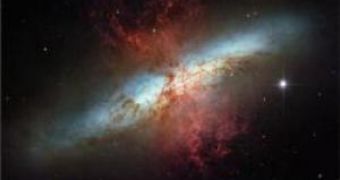By observing nearby galaxies, using the James Clerk Maxwell Telescope situated in Hawaii, astronomer Floris van der Tak observed in the dust clouds outside our galaxy, the first acidic cloud. The stellar and planetary formation might be explained through acidification inhibition, but astronomers cannot know for certain until the completion of the SRON Heterodyne Instrument for the Far-Infrared space telescope, which is scheduled to launch next year, designed to map the chemical composition of nearby galaxies and stars, by identifying the atomic and molecular spectral lines in submillimeter regions.
Stars and planets form through a process which involves rotating masses of gas which are drawn together and eventually collapse under the influence of gravitational fields. As pressure grows in the center of the newly created body, it compresses ever more the matter which will eventually heat up and light the whole gas mass to create a star that could potentially be orbited by one or more planets. However, solar systems are not as widespread as you might think, so scientists tried to find what the conditions for solar systems formation are, what triggers this process and what stops it.
Floris van der Tak thinks that a star and planet formation is greatly influenced by the amount of charged molecules inside the dust clouds, which are then manipulated by the exerted surrounding magnetic fields that agitate the cloud and prevent the star-forming process. To determine the ratio of acidic molecules inside a dust cloud, it is necessary to measure the quantity of charge molecules. However these ratios can be determined on Earth, since our atmosphere is rich in water content.
One of the solutions to this problem was to observe light coming from the galaxies, in high altitude regions where the air is more rarefied, thus the water content in the atmosphere is lower than average. The top of the Mauna Kea volcano in Hawaii is situated at an altitude of 4092 meters, where the James Clerk Maxwell Telescope is situated, providing a perfect spot to observe the rich acidic water dust clouds, situated in the galaxies M82 and Arp 220.
Even though both of the galaxies present high quantities of acidic water molecules, it seems that the causes that created them are completely different. In Arp 220 they are created under the influence of X-rays emitted by the central ultra massive black hole, whereas in M82, the high acidic content is triggered by ultraviolet radiation emitted by hot forming young stars, thus stopping the star forming process in the respective galaxies.
The launch of the SRON HIFI next year will present the possibility of better observing the dust of cloud from out of space.

 14 DAY TRIAL //
14 DAY TRIAL //